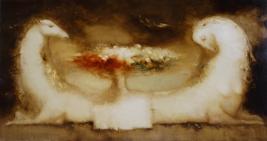Skrypka, Valeriy
Awakening

Oleksandr Fedoruk:
...Valery Skrypka, member of the National Art Union of Ukraine, was able to wow New York’s diverse art world by the enormity of his metaphorical talent with roots in the freedom-loving nature of the Zaporozhian Cossacks.... I have been many times to the studio of the artist Valery Skrypka, observing the paintings in progress, contemplating at length the finished works. I tried to penetrate and make home in the world of his images that constitute intellectual reflection and at the same time resemble magnificent dreams. I tried also to comprehend the messianic solemnity of his wondrous world-wanderers lost in somber thoughts; these figures reminded me in particular of the great Ukrainian Baroque-era philosopher and poet Hryhorii Skovoroda and his book The Garden of Divine Songs. I was impressed to see mysterious female figures emerge out of the depths of an enigmatic earthly yesterday or a fairytale unearthly tomorrow, and then captivate us through witnessing the birth of beauty. Skrypka’s neo-Baroque artistic world mesmerizes, surprises, and forces one to reflect upon Skovoroda’s wise words,
Valery Skrypka’s horsemen of the late 1980s apocalypse speak of virtual experience, of journeys to nowhere. Even the space they had invented and chose for themselves, seeking adventures astride their white or red horses with a nostalgia-inducing enterprising energy, felt too constricting to them. They acted in a realm populated by half-men, half-beasts, reminding one of the images of Bosch and Brueghel the Elder; they rushed to quench the thirst for knowledge and then quietly settled on the grass, like characters out of Rimbaud’s or Baudelaire’s poetry. Then they turned into Scythians who drew life force from light-filled visions, or transformed into the sphinxes of the steppes whose memory preserves the colorful dreams of the Polovetsians. When the half-men grew tired, they opened their eyes widely, and then you could see the ancient Byzantine wisdom shining in them. Skrypka populated his paintings with paradise women and paradise apples one could not taste. I looked at these figures somewhat perplexed, for this type of mysterious world one could previously see only in Persian miniatures or in the pages of the Balthasar Behem Codex. Wondrous is the world of The Rider on a White Horse (1999), wondrous are the beauties surrounded by peacocks, the way the unicorn tapestries in the bed chambers of King Louis XII were wondrous; wondrous are the Great Danes on a leash, as is the portrait of a clown that can be the envy of the classics from Montparnasse. We are traveling somewhere, although in reality we remain standing still. In the kingdom of calm one dwells among mysterious gardens, chariots, and eternal melancholy. Then, in 2006-2007, the Wings series was born, as those yearning to fly desperately need wings. But this also requires having gurus and disciples; one needs to have the seekers of wings. When he was already quite advanced in age, Matisse arrived at the need to search for his own Icaruses . . . The motif of awakening runs through all of Valery Skrypka’s endeavors and searches. His characters have no need to rush, for they were born to be the seekers of what is genuine. Some find wings in depicting battle scenes (Ucello, Leonardo Da Vinci), others find sunflowers sufficient (Van Gogh); still others turn to apocalyptic dramas (Duerer). If you yearn to fly somewhere, seek, and acquire wings. The Seller of Wings shall be found, along with The Wing Production and Testing Workshop. Your theoretical action is justified if you acquire a white horse and set out for a journey, even if under a guise of a new Don Quixote.







